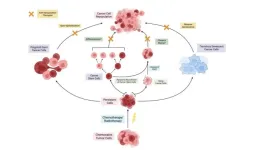(Press-News.org) RICHLAND, Wash.— From densely built urban cores to sprawling suburbia, cities are complex. This complexity can lead to temperature hot spots within cities, with some neighborhoods (and their residents) facing more heat than others.
Understanding this environmental disparity forms the spirit of new research led by scientists at the Department of Energy’s Pacific Northwest National Laboratory. In a new paper examining all major cities in the U.S., the authors find that the average Black resident is exposed to air that is warmer by 0.28 degrees Celsius relative to the city average. In contrast, the average white urban resident lives where air temperature is cooler by 0.22 degrees Celsius relative to the same average.
The new work, published last week in the journal One Earth, involved a two-part effort. The study’s authors aimed to produce a more useful nationwide estimate of urban heat stress—a more accurate account of how our body responds to outdoor heat. By creating and comparing these estimates against demographic data, they also tried to better understand which populations are most exposed to urban heat stress.
The findings reveal pervasive income- and race-based disparities within U.S. cities. Nearly all the U.S. urban population—94 percent, or roughly 228 million people—live in cities where summertime peak heat stress exposure disproportionately burdens the poor.
The study’s authors also find that people who now live within historically redlined neighborhoods, where loan applicants were once denied on racially discriminatory grounds, would be exposed to higher outdoor heat stress than their neighbors living in originally non-redlined parts of the city.
The work also highlights shortcomings in the typical approach scientists take in estimating urban heat stress at these scales, which frequently relies on satellite data. This conventional satellite-based method can overestimate such disparities, according to the new work. As the world warms, the findings stand to inform urban heat response plans put forward by local governments who seek to help vulnerable groups.
What is heat stress?
The human body has evolved to operate within a relatively narrow temperature range. Raise your core body temperature beyond just six or seven degrees and drastic physiological consequences soon follow. Cellular processes break down, the heart is taxed, and organs begin to fail.
Sweating helps. But the cooling power of sweating depends partly on how humid the environment is. When both heat and humidity are omnipresent and difficult to escape, the body struggles to adapt.
How is heat stress measured?
To measure heat stress, scientists use a handful of indicators, many of which depend on air temperature and humidity. Weather stations provide such data. Because most weather stations are outside of cities, though, scientists often rely on other means to get some idea about urban heat stress, including using sensors on satellites.
Those sensors infer the temperature of the land surface from measurements of thermal radiation. But such measurements fall short of delivering a full picture of heat stress, said lead author and Earth scientist TC Chakraborty. Measuring just the skin of the Earth, like the surface of a sidewalk or a patch of grass, said Chakraborty, offers only an idea of what it’s like to lay flat on that surface.
“Unless you’re walking around barefoot or lying naked on the ground, you’re not really feeling that,” said Chakraborty. “Land surface temperature is, at best, a crude proxy of urban heat stress.”
Indeed, most of us are upright, moving through a world where air temperature and moisture dictate how heat actually feels. And these satellite data are only available for clear-sky days—another limiting factor. More complete and physiologically relevant estimates of heat stress incorporate a blend of factors, which models can provide, said Chakraborty.
To better understand differences between satellite-derived land surface temperature and ambient heat exposure within cities, Chakraborty’s team examined 481 urbanized areas across the continental United States using both satellites and model simulations.
NASA’s Aqua satellite provided the land surface temperature; and through model simulations that account for urban areas, the authors generated nationwide estimates of all variables required to calculate moist heat stress. Two such metrics of heat stress—the National Weather Service’s heat index and the Humidex, often used by Canadian meteorologists—allowed the scientists to capture the combined impacts of air temperature and humidity on the human body.
They then identified heat stress hotspots across the country for summer days between 2014 and 2018. Overlaying maps of both historically redlined neighborhoods and census tracts, the team identified relationships between heat exposure and communities.
How is heat distributed within cities?
Residents in poorer neighborhoods often face greater heat stress. And a greater degree of income inequality in any given city often means greater heat stress exposure for its poorer residents.
Most U.S. cities, including heavily populated cities like New York, Los Angeles, Chicago, and Philadelphia, show this disparity. But the relationship between heat stress and race-based residential segregation is even more stark.
Roughly 87.5 percent of the cities studied show that Black populations live in parts of the city with higher land surface temperatures, warmer air, and greater moist heat stress. Moreover, the association between the degree of heat stress disparity and the degree of segregation between white and non-white populations across cities is particularly striking, said Chakraborty.
“The majority—83 percent—of non-white U.S. urban residents live in cities where outdoor moist heat stress disproportionately burdens them,” said Chakraborty, “Further, higher percentages of all races other than white are positively correlated with greater heat exposure no matter which variable you use to assess it.”
In the 1930s, the U.S. federal government’s Home Owners’ Loan Corporation graded neighborhoods in an effort to rank the suitability of real estate investments. This practice is known as “redlining,” where lower grades (and consequently fewer loans) were issued to neighborhoods composed of poorer and minority groups. The authors find that these redlined neighborhoods still show worse environmental conditions.
Neighborhoods with lower ratings face higher heat exposure than their non-redlined neighbors. Neighborhoods with higher ratings, in contrast, generally get less heat exposure.
This is consistent with previous research on originally redlined urban neighborhoods showing lower tree cover and higher land surface temperature. Chakraborty, however, notes that using land surface temperature would generally overestimate these disparities across neighborhood grades compared to using air temperature or heat index.
“Satellites give us estimates of land surface temperature, which is a different variable from the temperature we feel while outdoors, especially within cities,” said Chakraborty. “Moreover, the physiological response to heat also depends on humidity, which satellites cannot directly provide, and urbanization also modifies.”
The findings are not without uncertainty, the authors added. “Ground-based weather stations helped to dwindle down, but not eliminate, model bias,” said co-author Andrew Newman of the National Center for Atmospheric Research, who generated the model simulations. However, the results are still consistent with both theory and previous large-scale observational evidence.
What can be done?
Planting more trees often comes up as a potential solution to heat stress, said Chakraborty. But densely built urban cores, where poorer and minority populations in the U.S. often live, have limited space for trees. And many previous estimates of vegetation’s potential to cool city surroundings are also based solely on land surface temperature—they are perhaps prone to similar overestimation, the authors suggest.
More robust measurements of urban heat stress would help, they added. Factors like wind speed and solar insolation contribute to how heat actually affects the human body. But those factors are left out of most scientific assessments of urban heat stress because they are difficult to measure or model at neighborhood scales.
In addition to Chakraborty, PNNL authors of the new work include Yun Qian. Andrew Newman at the National Center for Atmospheric Research, Angel Hsu at the University of North Carolina-Chapel Hill, and Glenn Sheriff at Arizona State University are also authors. This work was supported by DOE’s Office of Science and the National Institutes of Health.
END
New nationwide modeling points to widespread racial disparities in urban heat stress
In proposing a better way to measure heat exposure in U.S. cities, researchers find that the average Black urban resident is exposed to disproportionately higher heat stress
2023-06-23
ELSE PRESS RELEASES FROM THIS DATE:
Do warmer temperatures make turtles better mothers?
2023-06-23
DURHAM, N.C. -- Warmer temperatures are known to make more turtle eggs become female hatchlings, but new research out of Duke University shows that those females also have a higher capacity for egg production, even before their sex is set.
This finding may explain why many animals besides turtles have temperature-dependent sex determination and why the system persists, despite seeming like a risky strategy. It may also provide a troubling glimpse of what could lie ahead in a warming world.
What the ...
Brain pathway identified that impairs postpartum social behavior after adolescent stress
2023-06-23
BIRMINGHAM, Ala. – Stress during adolescence can cause postpartum behavioral changes in women and other mammals, including depression and changes in social behavior after the birth of a child.
However, the neural circuit mechanisms by which adolescent stress leads to later changes in postpartum social behavior are unclear. In a Nature Communications study, University of Alabama at Birmingham researcher Minae Niwa, Ph.D., used a mouse model and cutting-edge neurobiological techniques to show how psychological stress during adolescence alters neuronal functions in the brain, resulting in altered postpartum social behavior.
This ...
People are falsely denying firearm ownership, and it’s not who you might think
2023-06-23
Some firearm owners may not want researchers to know they own firearms, according to a study by the New Jersey Gun Violence Research Center at Rutgers.
In a study published in Social Psychiatry and Psychiatric Epidemiology, researchers found that based on their answers to a variety of other questions, a group of individuals appeared as though they might be falsely denying firearm ownership when directly asked by researchers.
While some of these individuals resemble what previous research indicated to be a typical American firearm owner (e.g., white, male), others looked quite different (racial or ethnic minority, female, ...
Source of common kidney disease lies outside the kidney, study suggests
2023-06-23
NEW YORK, NY--The cause of a common kidney disease likely lies outside the kidney, according to a new study led by Columbia University researchers. The study, which uncovered 16 new locations in the genome linked to immunoglobulin A (IgA) nephropathy, confirms an earlier hypothesis that the immune system has an important role in driving the disease and points toward new strategies for detecting and treating it.
No targeted treatments have been approved to treat IgA nephropathy, largely because the underlying cause of the disease has not been well understood.
Identifying genes linked ...
Stanford Medicine-led research identifies a subtype of depression
2023-06-23
Scientists at Stanford Medicine conducted a study describing a new category of depression — labeled the cognitive biotype — which accounts for 27% of depressed patients and is not effectively treated by commonly prescribed antidepressants.
Cognitive tasks showed that these patients have difficulty with the ability to plan ahead, display self-control, sustain focus despite distractions and suppress inappropriate behavior; imaging showed decreased activity in two brain regions responsible for those tasks.
Because depression has traditionally been defined as a mood disorder, ...
Stanford University’s Innovative Medicines Accelerator and Intonation Research Laboratories form a collaboration to fight cancerous neuroendocrine tumors
2023-06-23
Stanford University’s Innovative Medicines Accelerator (IMA) and Intonation Research Laboratories (Intonation) have formed a collaboration to develop treatments that target cancerous neuroendocrine tumors, or tumors that form from hormone-releasing cells.
The goal of the collaboration is to reduce the time and resources it takes to translate a biomedical breakthrough into a clinically and commercially viable medicine.
“I’m excited about this collaboration with Intonation Research Laboratories, which has the potential to speed ...
Extinct warbler’s genome sequenced from museum specimens
2023-06-23
The Bachman’s warbler, a songbird that was last seen in North America nearly 40 years ago, was a distinct species and not a hybrid of its two living sister species, according a new study in which the full genomes of seven museum specimens of the bird were sequenced. Genome comparisons of Bachman’s warbler with the golden-winged and blue-winged warblers also helped researchers identify a new candidate gene involved in feather pigmentation in the group. A paper describing the study, led by Penn State researchers, highlights the crucial role that museum collections can play in science and appears ...
Baylor researchers examine relationship between imprisoned mothers and their adolescent children’s risk behaviors
2023-06-23
WACO, Texas (June 23, 2023) – Women represent the fastest-growing population in U.S. institutional corrections facilities. In the past four decades, the number of women incarcerated has increased by more than 475%, rising from 26,326 in 1980 to 152,854 in 2020.Because the majority of imprisoned women are mothers, a conservative estimate indicates that at least one million American children have experienced maternal incarceration, and a substantial portion of them are adolescents.
Evidence suggests that maternal incarceration is a risk factor for adolescents’ ...
NSF CAREER Awardee develops a 1-minute frailty testing platform
2023-06-23
A layperson might think of “frail” as simply a synonym for “weak” or “fragile.” But in the medical field, frailty is a specific term, meaning – due to factors including inflammation and hormone shifts – a patient has a lack of physiological reserve, or a reduced ability to tolerate stress.
“That stress can be anything from the simple event of falling to getting COVID or another infectious disease,” said Nima Toosizadeh, assistant professor of biomedical engineering and medicine. “Or, it can be a treatment that might be invasive for patients. Knowing who can tolerate the stress is critical.”
It ...
Cancer cell repopulation after therapy: which is the mechanism?
2023-06-23
“Approaches targeted to prevent this post-therapy cancer cell repopulation should be uncovered to prevent tumor relapse and thus increase overall survival from this devastating disease.”
BUFFALO, NY- June 23, 2023 – A new research perspective was published in Oncoscience (Volume 10) on June 1, 2023, entitled, “Cancer cell repopulation after therapy: which is the mechanism?”
The past two decades have brought great progress in the treatment of cancer as patients with the disease live ...
LAST 30 PRESS RELEASES:
Chicago health information leader recognized for raising CPR readiness and blood pressure awareness
The Intimate Animal, a new book from Kinsey Institute Executive Director Dr. Justin Garcia
When blue-collar workers lose union protection, they try self-employment
New video dataset to advance AI for health care
MEA-based graph deviation network for early autism syndrome signatures in human forebrain organoids
New modeling approach sheds light on rare gut disease
Study documents potentially hazardous flame retardants in firefighter gear
Can certain bacteria regulate aging of the immune system and its related alterations?
AI model helps diagnose often undetected heart disease from simple EKG
There are fewer online trolls than people think
Cell membrane fluctuations produce electricity
Jeonbuk National University study shows positive parenting can protect adolescents against self-harm
Surface-engineered ZnO nanocrystals to tackle perfluoroalkyl substance contamination
This new understanding of T cell receptors may improve cancer immunotherapies
A new fossil face sheds light on early migrations of ancient human ancestor
A new immunotherapy approach could work for many types of cancer
A new way to diagnose deadly lung infections and save lives
40 percent of MRI signals do not correspond to actual brain activity
How brain-inspired algorithms could drive down AI energy costs
Gum disease may be linked to plaque buildup in arteries, higher risk of major CVD events
Contrails are a major driver of aviation’s climate impact
Structure of dopamine-releasing neurons relates to the type of circuits they form for smell-processing
Reducing social isolation protects the brain in later life
Keeping the heart healthy increases longevity even after cancer
Young adults commonly mix cannabis with nicotine and tobacco
Comprehensive review illuminates tau protein's dual nature in brain health, disease, and emerging psychiatric connections
Book prepares K-12 leaders for the next public health crisis
Storms in the Southern Ocean mitigates global warming
Seals on the move: Research reveals key data for offshore development and international ecology
Sports injuries sustained during your period might be more severe
[Press-News.org] New nationwide modeling points to widespread racial disparities in urban heat stressIn proposing a better way to measure heat exposure in U.S. cities, researchers find that the average Black urban resident is exposed to disproportionately higher heat stress




